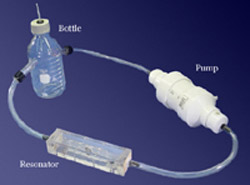It whistles; change in pitch tells all in this new sonic gas analyzer

Components of the new Penn State sonic gas analyzer. The sample chamber (bottle) is connected to the analyzer cell (resonator) by a sealed fan (pump) that circulates the gas mixture through the system.
Penn State researchers have developed a prototype sonic gas analyzer that automatically and continuously tracks the concentration of a gas in an air/gas mixture based on changes in pitch.
Miguel Horta, doctoral candidate in acoustics who is currently working on the sonic gas analyzer as part of his dissertation, says, “The system automatically cancels out the background and flow noise and can detect changes in gas concentration as low as 0.003 percent – plenty sensitive enough, for example, to let you know if you’ve got an explosive mixture.”
The Penn State researchers are developing the current prototype to track continuously the concentrations of hydrogen produced by bacteria in microbial fuel cells (MFC). In MFCs, bacteria feed on the organic matter in wastewater and produce hydrogen for use as fuel while simultaneously cleaning the water.
However, the researchers say their new system also could be adapted for tracking toxic or flammable gases in mines, sewers or landfills, for hydrogen detectors in battery compartments of boats and electric cars or in industries where gases are consumed as feedstocks.
Horta will detail the system and his measurements on helium, sulfur hexafluoride and hydrogen produced by non-bacterial sources in a talk set for Oct. 19 at the Acoustical Society of America/Society of Noise Control Engineers (ASA/Noise-Con 2005) in Minneapolis, Minn. His presentation is titled Sonic Gas Analyzer for Microbiological Metabolic Measurements. His co-author is his thesis adviser, Dr. Steven Garrett, the United Technologies Corp. professor of acoustics.
Garrett explains that, in the Penn State sonic gas analyzer, a miniature speaker produces a tone barely audible outside the resonator that sounds like a whistle. Two tiny microphones capture the tone, called a resonance frequency, and the two-microphone outputs are then subtracted to double the signal of interest and cancel any extraneous noise before being fed to an electronic tracking system, called a phase-locked loop. This tracking system determines the changes in the resonance frequency caused by the changes in gas concentration, while simultaneously correcting for any changes in the gas temperature.
Horta adds, “If the concentration of a gas in the gas/air mixture passing through the system changes, the new concentration will affect the sound’s speed which will, in turn, change the resonance frequency. That change in resonance frequency or pitch, as detected by the microphones and tracking system, tells us what the change in gas concentration is at every instant without disturbing the system or requiring extraction of gas samples.”
Sonic gas analyzers can be used in the same applications as thermal conductivity analyzers, the researchers point out. However, since the sonic gas analyzer only introduces sound, it doesn’t change the temperature of the gas mixture, as do thermal conductivity analyzers.
Garrett notes, “Keeping the temperature unaltered by external devices is crucial to obtaining detailed information about the gas mixture in a microbial fuel cell without affecting the bacteria.”
Horta’s measurements on helium, sulfur hexafluoride, and hydrogen show an immediate response by the analyzer to the introduction of a contaminating gas. The necessary time for the gases to become thoroughly mixed within the system varies from approximately 30 seconds for lighter gases like helium and hydrogen to about one minute for the heavier sulfur hexafluoride. Once the gases are mixed, the resonance frequency is stable to about 0.02 Hz, corresponding to a concentration resolution on the order of 30 parts-per-million.
The absolute accuracy of the change in frequency has an uncertainty of about 0.13 Hz for sulfur hexafluoride and 0.6 Hz for helium, corresponding to absolute accuracies in concentration of 0.015 percent and 0.02 percent respectively. In the case of hydrogen, the uncertainty of a concentration measurement is 0.118 percent.
Garrett explains, “An uncertainty of 0.1 percent means that, if we measure a concentration of, say, two percent of helium in air, our statistical error analysis tells us that the value is, for sure, between 1.9 percent and 2.1 percent.”
The researchers are working on modifications in the design of the analyzer to further improve the accuracy of the measurements.
The research project is supported by the endowment for the United Technologies Corporation Professorship that Garrett holds.
Media Contact
More Information:
http://www.psu.eduAll latest news from the category: Power and Electrical Engineering
This topic covers issues related to energy generation, conversion, transportation and consumption and how the industry is addressing the challenge of energy efficiency in general.
innovations-report provides in-depth and informative reports and articles on subjects ranging from wind energy, fuel cell technology, solar energy, geothermal energy, petroleum, gas, nuclear engineering, alternative energy and energy efficiency to fusion, hydrogen and superconductor technologies.
Newest articles

Parallel Paths: Understanding Malaria Resistance in Chimpanzees and Humans
The closest relatives of humans adapt genetically to habitats and infections Survival of the Fittest: Genetic Adaptations Uncovered in Chimpanzees Görlitz, 10.01.2025. Chimpanzees have genetic adaptations that help them survive…

You are What You Eat—Stanford Study Links Fiber to Anti-Cancer Gene Modulation
The Fiber Gap: A Growing Concern in American Diets Fiber is well known to be an important part of a healthy diet, yet less than 10% of Americans eat the minimum recommended…

Trust Your Gut—RNA-Protein Discovery for Better Immunity
HIRI researchers uncover control mechanisms of polysaccharide utilization in Bacteroides thetaiotaomicron. Researchers at the Helmholtz Institute for RNA-based Infection Research (HIRI) and the Julius-Maximilians-Universität (JMU) in Würzburg have identified a…



